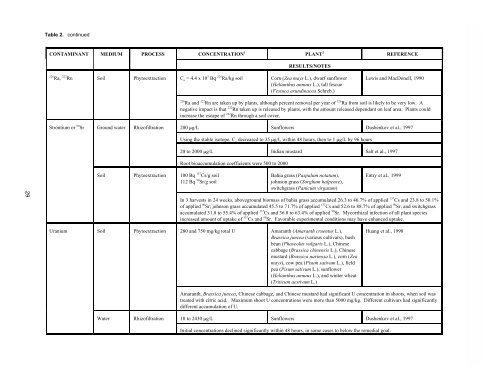Ground Water Issue - Plant Tissue Culture Research at the Univ. of ...
Ground Water Issue - Plant Tissue Culture Research at the Univ. of ...
Ground Water Issue - Plant Tissue Culture Research at the Univ. of ...
You also want an ePaper? Increase the reach of your titles
YUMPU automatically turns print PDFs into web optimized ePapers that Google loves.
Table 2. continuedCONTAMINANT MEDIUM PROCESS CONCENTRATION 1 PLANT 2 REFERENCERESULTS/NOTES226 Ra, 222 Rn Soil Phytoextraction C o = 4.4 x 10 3 Bq 226 Ra/kg soil Corn (Zea mays L.), dwarf sunflower(Helianthus annuus L.), tall fescue(Festuca arundinacea Schreb.)Lewis and MacDonell, 1990226 Ra and 222 Rn are taken up by plants, although percent removal per year <strong>of</strong> 226 Ra from soil is likely to be very low. Aneg<strong>at</strong>ive impact is th<strong>at</strong> 222 Rn taken up is released by plants, with <strong>the</strong> amount released dependant on leaf area. <strong>Plant</strong>s couldincrease <strong>the</strong> escape <strong>of</strong> 222 Rn through a soil cover.Strontium or 90 Sr <strong>Ground</strong> w<strong>at</strong>er Rhiz<strong>of</strong>iltr<strong>at</strong>ion 200 g/L Sunflowers Dushenkov et al., 1997Using <strong>the</strong> stable isotope, C o decreased to 35 g/L within 48 hours, <strong>the</strong>n to 1 g/L by 96 hours20 to 2000 g/L Indian mustard Salt et al., 1997Root bioaccumul<strong>at</strong>ion coefficients were 500 to 200029Soil Phytoextraction 100 Bq 137 Cs/g soil112 Bq 90 Sr/g soilBahia grass (Paspalum not<strong>at</strong>um),johnson grass (Sorghum halpense),switchgrass (Panicum virg<strong>at</strong>um)Entry et al., 1999In 3 harvests in 24 weeks, aboveground biomass <strong>of</strong> bahia grass accumul<strong>at</strong>ed 26.3 to 46.7% <strong>of</strong> applied 137 Cs and 23.8 to 50.1%<strong>of</strong> applied 90 Sr; johnson grass accumul<strong>at</strong>ed 45.5 to 71.7% <strong>of</strong> applied 137 Cs and 52.6 to 88.7% <strong>of</strong> applied 90 Sr; and switchgrassaccumul<strong>at</strong>ed 31.8 to 55.4% <strong>of</strong> applied 137 Cs and 36.8 to 63.4% <strong>of</strong> applied 90 Sr. Mycorrhizal infection <strong>of</strong> all plant speciesincreased amount <strong>of</strong> uptake <strong>of</strong> 137 Cs and 90 Sr. Favorable experimental conditions may have enhanced uptake.Uranium Soil Phytoextraction 280 and 750 mg/kg total U Amaranth (Amaranth cruentus L.),Brassica juncea (various cultivars), bushbean (Phaseolus vulgaris L.), Chinesecabbage (Brassica chinensis L.), Chinesemustard (Brassica narinosa L.), corn (Zeamays), cow pea (Pisum s<strong>at</strong>ivum L.), fieldpea (Pisum s<strong>at</strong>ivum L.), sunflower(Helianthus annuus L.), and winter whe<strong>at</strong>(Triticum aestivum L.)Huang et al., 1998Amaranth, Brassica juncea, Chinese cabbage, and Chinese mustard had significant U concentr<strong>at</strong>ion in shoots, when soil wastre<strong>at</strong>ed with citric acid. Maximum shoot U concentr<strong>at</strong>ions were more than 5000 mg/kg. Different cultivars had significantlydifferent accumul<strong>at</strong>ion <strong>of</strong> U.<strong>W<strong>at</strong>er</strong> Rhiz<strong>of</strong>iltr<strong>at</strong>ion 10 to 2430 g/L Sunflowers Dushenkov et al., 1997Initial concentr<strong>at</strong>ions declined significantly within 48 hours, in some cases to below <strong>the</strong> remedial goal.
















